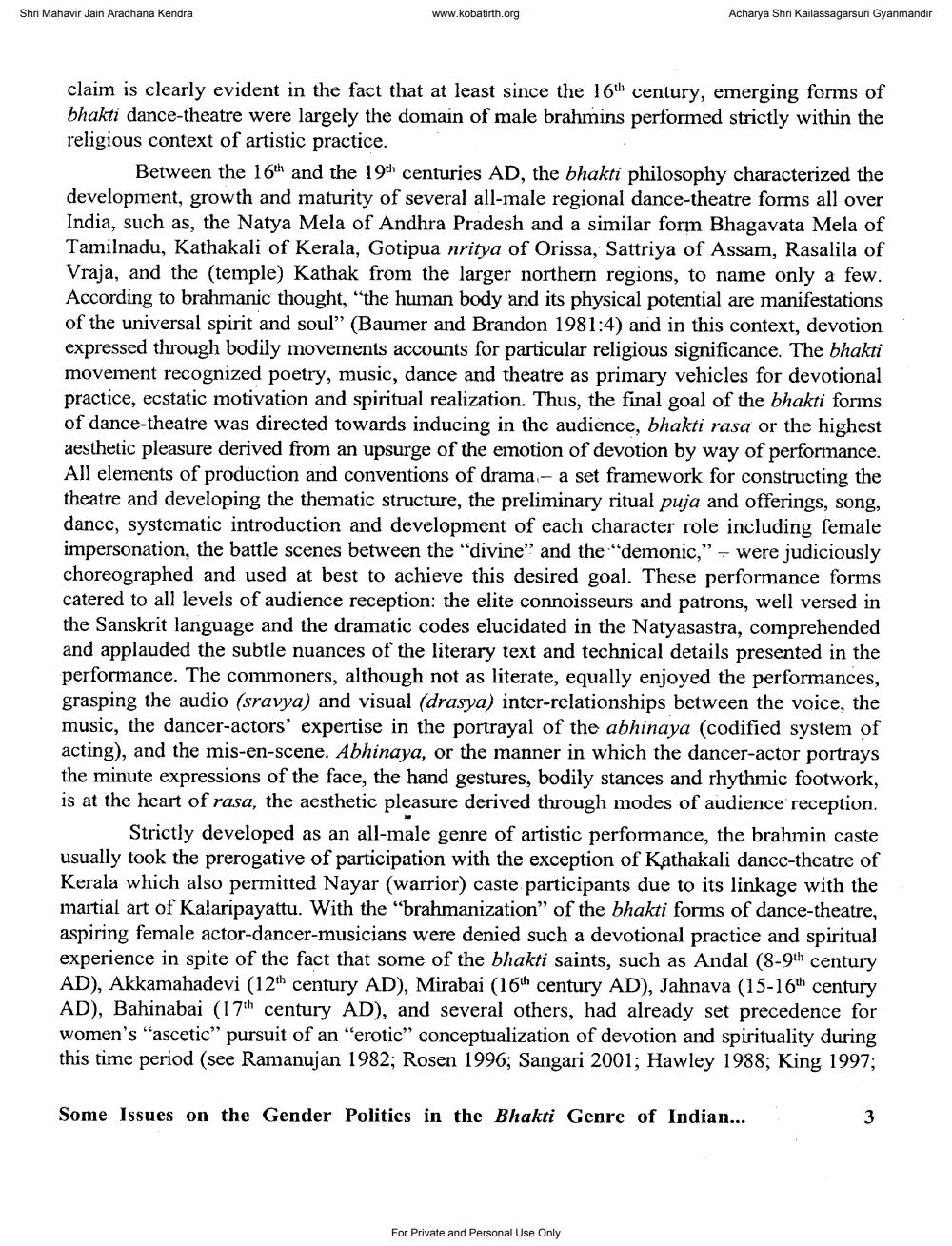Book Title: Samipya 2008 Vol 25 Ank 03 04 Author(s): R T Savalia Publisher: Bholabhai Jeshingbhai Adhyayan Sanshodhan Vidyabhavan View full book textPage 6
________________ Shri Mahavir Jain Aradhana Kendra www.kobatirth.org Acharya Shri Kailassagarsuri Gyanmandir claim is clearly evident in the fact that at least since the 16th century, emerging forms of bhakti dance-theatre were largely the domain of male brahmins performed strictly within the religious context of artistic practice. Between the 16th and the 19th centuries AD, the bhakti philosophy characterized the development, growth and maturity of several all-male regional dance-theatre forms all over India, such as, the Natya Mela of Andhra Pradesh and a similar form Bhagavata Mela of Tamilnadu, Kathakali of Kerala, Gotipua nritya of Orissa, Sattriya of Assam, Rasalila of Vraja, and the (temple) Kathak from the larger northern regions, to name only a few. According to brahmanic thought, "the human body and its physical potential are manifestations of the universal spirit and soul" (Baumer and Brandon 1981:4) and in this context, devotion expressed through bodily movements accounts for particular religious significance. The bhakti movement recognized poetry, music, dance and theatre as primary vehicles for devotional practice, ecstatic motivation and spiritual realization. Thus, the final goal of the bhakti forms of dance-theatre was directed towards inducing in the audience, bhakti rasa or the highest aesthetic pleasure derived from an upsurge of the emotion of devotion by way of performance. All elements of production and conventions of drama.- a set framework for constructing the theatre and developing the thematic structure, the preliminary ritual puja and offerings, song, dance, systematic introduction and development of each character role including female impersonation, the battle scenes between the "divine" and the "demonic," - were judiciously choreographed and used at best to achieve this desired goal. These performance forms catered to all levels of audience reception: the elite connoisseurs and patrons, well versed in the Sanskrit language and the dramatic codes elucidated in the Natyasastra, comprehended and applauded the subtle nuances of the literary text and technical details presented in the performance. The commoners, although not as literate, equally enjoyed the performances, grasping the audio (sravya) and visual (drasya) inter-relationships between the voice, the music, the dancer-actors' expertise in the portrayal of the abhinaya (codified system of acting), and the mis-en-scene. Abhinaya, or the manner in which the dancer-actor portrays the minute expressions of the face, the hand gestures, bodily stances and rhythmic footwork, is at the heart of rasa, the aesthetic pleasure derived through modes of audience reception. Strictly developed as an all-male genre of artistic performance, the brahmin caste usually took the prerogative of participation with the exception of Kathakali dance-theatre of Kerala which also permitted Nayar (warrior) caste participants due to its linkage with the martial art of Kalaripayattu. With the "brahmanization" of the bhakti forms of dance-theatre, aspiring female actor-dancer-musicians were denied such a devotional practice and spiritual experience in spite of the fact that some of the bhakti saints, such as Andal (8-9th century AD), Akkamahadevi (12th century AD), Mirabai (16th century AD), Jahnava (15-16th century AD), Bahinabai (17th century AD), and several others, had already set precedence for women's "ascetic" pursuit of an "erotic" conceptualization of devotion and spirituality during this time period (see Ramanujan 1982; Rosen 1996; Sangari 2001; Hawley 1988; King 1997; Some Issues on the Gender Politics in the Bhakti Genre of Indian... For Private and Personal Use Only 3Page Navigation
1 ... 4 5 6 7 8 9 10 11 12 13 14 15 16 17 18 19 20 21 22 23 24 25 26 27 28 29 30 31 32 33 34 35 36 37 38 39 40 41 42 43 44 45 46 47 48 49 50 51 52 53 54 55 56 57 58 59 60 61 62 ... 164
